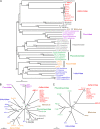Detection of novel sequences related to african Swine Fever virus in human serum and sewage
- PMID: 19812170
- PMCID: PMC2786824
- DOI: 10.1128/JVI.00638-09
Detection of novel sequences related to african Swine Fever virus in human serum and sewage
Abstract
The family Asfarviridae contains only a single virus species, African swine fever virus (ASFV). ASFV is a viral agent with significant economic impact due to its devastating effects on populations of domesticated pigs during outbreaks but has not been reported to infect humans. We report here the discovery of novel viral sequences in human serum and sewage which are clearly related to the asfarvirus family but highly divergent from ASFV. Detection of these sequences suggests that greater genetic diversity may exist among asfarviruses than previously thought and raises the possibility that human infection by asfarviruses may occur.
Figures



References
-
- Bastos, A. D., M. L. Penrith, C. Cruciere, J. L. Edrich, G. Hutchings, F. Roger, E. Couacy-Hymann, and R. Thomson. 2003. Genotyping field strains of African swine fever virus by partial p72 gene characterisation. Arch. Virol. 148:693-706. - PubMed
-
- Baylis, S. A., L. K. Dixon, S. Vydelingum, and G. L. Smith. 1992. African swine fever virus encodes a gene with extensive homology to type II DNA topoisomerases. J. Mol. Biol. 228:1003-1010. - PubMed
-
- Boshoff, C. I., A. D. Bastos, L. J. Gerber, and W. Vosloo. 2007. Genetic characterisation of African swine fever viruses from outbreaks in southern Africa (1973-1999). Vet. Microbiol. 121:45-55. - PubMed
-
- Chapman, D. A., V. Tcherepanov, C. Upton, and L. K. Dixon. 2008. Comparison of the genome sequences of non-pathogenic and pathogenic African swine fever virus isolates. J. Gen. Virol. 89:397-408. - PubMed
Publication types
MeSH terms
Substances
Grants and funding
LinkOut - more resources
Full Text Sources
Other Literature Sources

